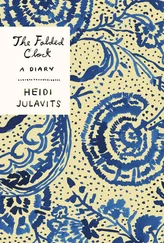Me, I was an unreflective repository for people’s sorrow. A trash can of sorrow.
I tried and I tried to get inside Marta’s office.
No surprise. I failed.

I took the elevator to the lobby. Empty. Even the concierge was gone. I went outside again and waited for my migraine in Gutenberg Square. Maybe I’d tempt another snapper to take my photograph.
Two nodders, a man and a woman, kneeled in a flowerbed, slow-motion weeding, or maybe they were holding on to the weeds to steady themselves. Closer by, an old man slept, a Leica over his crotch. His beard was so white it had begun to yellow, like a peeled apple exposed to air.
I sat on the bench across from him. I coughed. The old snapper awoke.
We made small talk. I told him I was staying at the Goergen.
“Your face-lift has healed nicely,” he said.
“I’m being attacked,” I corrected him.
“Age is a warrior,” he said.
He aimed his camera toward the Goergen. A delivery truck had pulled up; a man unloaded crates of vegetables.
“Why do you care about turnips?” I asked.
The snapper reached into his vest pocket and removed a tin of chewing tobacco.
“I’m here to photograph a woman named Borka Erdos,” he said.
Ah , I thought. I’ve heard about you .
“I am her conscience,” he said wistfully. “Or maybe she is mine.”
“She must have been very beautiful once,” I said, meaning prior to her car accident.
“Only my pictures can say,” the old snapper declaimed.
He offered to take me to his flat to show me these pictures. He bragged, as further incentive, that his flat contained “the underground snapper archives of Europe.”
“I own photographs of everyone who was everyone,” he said.
“Do you own photographs of Dominique Varga?” I asked.
He appeared miffed.
“Lady,” he said. “Of course I do.”
We drove a short distance to his flat — one vast room — that indeed appeared to house the snapper archives of Europe. Side-by-side filing cabinets obscured every inch of available wall.
He withdrew a file folder and placed it on a table.
“Who is this?” I asked of a young woman in a shift patterned by saucer-sized dots.
“Borka,” he said.
If I strained I saw the resemblance — mostly in the nose, but the rest of the features belonged to a woman I’d never seen before. When Borka had said her face was not her own, she hadn’t been exaggerating.
The old snapper made coffee while I perused. The youthful photographs — Borka in her thirties — were followed by photos of a much older Borka, a Borka I could more easily square with the post-car-accident Borka I knew. The snapper owned no photos, however, of the intervening twenty-odd years.
He returned with two coil mugs handmade by a child, or at least their weighty lumpenness suggested this to be the case. To the touch mine was greasy, as though coated with a sorrowful residue like Helena’s ring. I set the mug down, determined not to touch it again. This snapper, I did not want to know about his life.
“I’m out of sugar,” he apologized.
I asked him about the gap in his file, the decades between the two Borkas.
“Tell me what I should have done,” he said, interpreting my question as a criticism. “The world thought she was dead.”
He told me that Borka, at the age of forty, had gone missing while on vacation in Ibiza.
“Ibiza?” I said. In my head I heard the words heiress and masked women and prosthetic hands . I was stunned, but I wasn’t. What a moron I’d been not to have put the pieces together already.
“People believed she was killed in a car accident,” the old snapper said. “That she drove her Mercedes into a cliff. But I promise you, it was no accident. She did it for Dominique Varga. She did it for art.”
He sighed.
“The girls in those days,” he said. “What wouldn’t they sacrifice for Varga? I’m lucky my Rita never met her.”
“And Borka didn’t die,” I said, finishing his previous thought.
“Not in the usual sense,” he said.
Little surprise, then, that Borka would claim to have information about Varga’s current whereabouts. She not only knew the woman, she’d ruined her face for her. Also, I felt a tiny bit chastened by this irony, or this coincidence, or this perversity: my most fruitful Varga research source didn’t require me to regress anywhere. All I had to do was take the elevator upstairs to Borka’s room.
“No doubt the family was relieved she was gone,” the old snapper continued. “Borka was no picnic. Always needing to be the center of attention, and eventually she becomes a sort of movie star but she pays for the privilege with her face. So she disappears. The husband never remarries. And then, twenty years later the husband dies, and there is no one to take over the business, and Borka comes back from wherever she’s been, not dead at all.”
“How odd,” I said. But upon reflection it wasn’t so odd. Borka had vanished herself and unvanished herself. This was no longer an alien paradigm.
The old snapper shrugged. “Sometimes pretending to be dead is best for all involved.”
“Speaking of which,” I said. I asked him to show me his photos of Dominique Varga.
He scrutinized me, possibly trying to divine if I, too, were the sort of weak girl who might fall sway to her unhealthy influence.
He deemed me immune.
His Varga file proved lean. Inside were stills of Varga on the sets of her various films, such as Simone Moreault . Also, not that I was expecting it, but I realized upon not finding it that I’d been hoping — maybe there would be a picture of my mother.
“That’s it?” I asked.
The old snapper bristled.
“I mean,” I said, “they’re wonderful.”
“But I haven’t shown you the best ones,” he said. “I keep them in a special place. Someday I will sell them and make an honest fortune.”
The snapper retrieved two photos from his bedroom. The first was of a woman’s face slashed to bits and surrounded by glass.
“A still,” he said. “Of Borka. No one ever found copies of the car accident film, but I have proof — it did exist.”
Borka, I had to admit, appeared pretty convincingly dead, her face a pulverized fruit. I better appreciated what a good job her initial plastic surgeon had done, given the original mess.
“But that is not the most valuable,” said the old snapper. “This one is the most valuable.”
He handed me a photo of a young Dominique Varga — she looked like a teenager — face shadowed beneath a straw visor, breastfeeding a baby.
“Which film is this from?” I asked.
“No film,” he said. “That is from life.”
“She had a baby?” I asked.
“A daughter,” he said.
Irenke. So she hadn’t been lying. Varga did have a daughter. But whether Irenke was that daughter remained unsubstantiated. Given the number of desperate acolytes Varga attracted, and Irenke’s doomy vibe, it seemed prudent to wonder.
“What happened to her?” I asked.
“She is dead like my Rita,” the old snapper said. “Pottery was Rita’s life. That’s her kiln in the corner.”
“Which one is dead?” I asked.
“Everybody is dead,” said the old snapper, extending his arms to indicate all the inhabitants of his loft, the 2-D people morgued in the file cabinets.
It struck me that he was a little bit senile, my old snapper.
“The child, too?” I asked.
“A face is like a rune stone,” he said. “A face says to me ‘long life’ or ‘happy marriage’ or ‘early death by wrong raising.’ But she was such a terrible potter, my wife,” he sighed. “That she was considered the artist in the family, it was a bad joke we could never, for the health of the marriage, laugh about.”
Читать дальше













